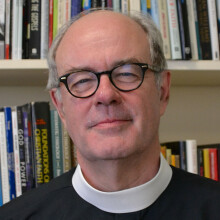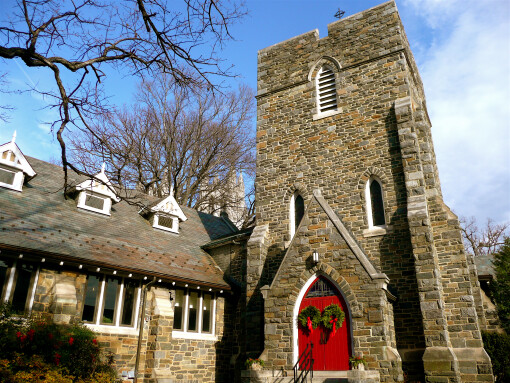Meditation #6

Speaker: The Rev'd Geoffrey M. St J. Hoare
And so we come to the end of the story for today and Jesus’ burial at the hands of a righteous man called Joseph. These few short sentences are packed with theological significance as we attend to righteousness, the Law and the Sabbath.
Righteousness is often thought of as being a state of moral rectitude or ethical conduct, but is really so much more than that. Righteousness is first and foremost and attribute of God and it implies so much more than ‘right action’. It is more like ‘right being’. I translate it as ‘right relationship’ or that state of being when all is right with us and the world, --right with God , right with others, right with the whole of creation. When Joseph is declared ‘righteous’ it is because he was waiting expectantly for the kingdom or reign or ‘rulership’ of God. Sometimes in our compromised world so marked and scarred by the kind of sin and brokenness that brought about Jesus’ death on a cross, --sometime righteousness can be marked as rightly ordered desire. We strive for righteousness in relationship with Jesus. In and by God’s grace we might be accounted righteous enough to taste the first fruits of the gospel promise: a measure of freedom from anxiety, deep joy and peace marked by justice.
In the days of our story, Joseph of course would have seen and understood re4ighteousness as ‘observing the commandments of the Torah’ and as a member of the council, he would have known that it says in Deuteronomy, Chapter 21 (21:22-23)“when someone is convicted of a crime punishable by death and is executed, and you hang him on a tree, his corpse must not remain all night upon the tree; you shall bury him that same day, for anyone hung on a tree is under God’s curse. You must not defile the land that the Lord your God is giving you for your possession.” This curse from dying on a tree became important to the theology of the early church. Luke tells us twice in the book of Acts that “the God of our ancestors raised up Jesus, whom you killed, by hanging him on a tree” (5:30) and again “They put hi9m to death by hanging him on a tree.” (10:39). St Paul picks this up in one of his most theologically dense letter when he writes to the Galatians: “Christ redeemed us from the curse of the law by becoming a curse for us—for it is written, ‘Cursed is everyone who is hanged on a tree’” (3:13). Joseph was a righteous observer of the law who hungered and thirsted for the reign of God and who made sure that the law was observed by taking down Jesus’ body from the cross, wrapping it in a linen cloth reminiscent of the swaddling cloth with which he was wrapped at his birth, and laying it in a rock hewn tomb where no one had ever been laid. He not only obeyed the commandment, he also showed Jesus great respect, saving the body from being tossed in a pauper’s grave.
The curse of the tree, especially as expressed by Paul has led many to think of Jesus as a substitute for our own punishment. While I believe that there are ways of understanding t is death as substitutionary, it is precisely as an inversion of that all too human tendencies to sacralize violence by saying that the bloodshed was redemptive and that Jesus essentially took the punishment for us. In fact he inverted the process and placed himself in the story as a human substituting for an animal, --the lamb of God—thus showing that all that is going on here is that banality of murder as a means of addressing human anxiety, revealing this shameful death for what it is, --not the shame of one who hangs on a tree, but the shame of all those tendencies in us that want to make meaning out of sheer banality.[1]
And we finish with the observation of the Sabbath. No less a Christian that G. K. Chesterton saw this Sabbath as the “last Sabbath of the old creation,” reflecting the day God rested after the work of creation. At this point, we do not know that there will be a Sabbath to come in a new creation. All we know is that as people who hunger and thirst after righteousness is that Jesus went to his death trusting in God even through the horror of the degradation of human violence at the hands of human power. This was the final act of a life of absolute integrity, --a fully integrated man, who kept faith with the source of his life even unto death. What are we left with today? Well, we are left with honoring the dead and continuing to practice faith even if we doubt, and even in the face of the banality and meaninglessness of this death. We are left to remember God’s power of creation and its Sabbath rest as we continue to wait expectantly for the Basileia tou Theou, the Reign of God, made manifest, --our waiting marked by the silence of the tomb. Let us pray…
[1] See James Alison, “An Atonement Update” in Undergoing God: Dispatches from the Scene of a Break-in (Crossroad, 2006) especially pp. 58-59
 Welcome to St. Alban’s Church! Every Sunday, and most days in between, people gather in this place to worship, to learn, to grow, to share the joys and struggles of our lives, and to seek God’s grace in the midst of our lives. We do not come because we have it all figured out, but because we are seeking light on the way. We come as we are and welcome one another.
Welcome to St. Alban’s Church! Every Sunday, and most days in between, people gather in this place to worship, to learn, to grow, to share the joys and struggles of our lives, and to seek God’s grace in the midst of our lives. We do not come because we have it all figured out, but because we are seeking light on the way. We come as we are and welcome one another.

